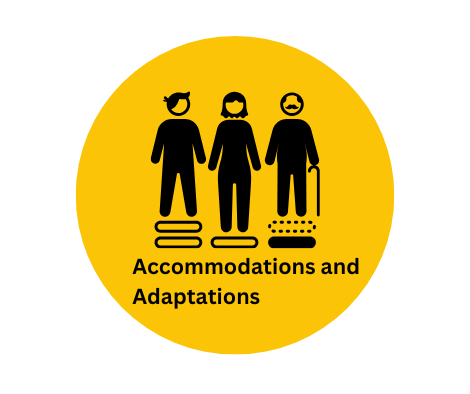
Accommodations and Adaptations
After a discussion about how a class operates, the next step in setting up a support system for both student and instructor is to talk about what the student with an ID can do within the class to meet the overall expectations of the class. For some students with ID, the class was selected because it is part of a certificate program within an industry regulated program. In this case, the accommodations or modifications that can be provided if they do not modify the skills to be mastered. That means the way the content can be adapted, but the content cannot be changed as all completers of industry standard courses must demonstrate similar characteristics. Some adaptations might be the answer to a successful inclusion experience.
Owiny, Brawand, and Josephson (2017) provide examples of common classroom adaptations that can be incorporated into a support plan for students in the FPCTP program. Please note that that not all the options provided may be permissible in testing situations and selecting only permissible adaptations may help in the long run. The adaptations described in the table can be used to adapt the way the content is presented but leaves the content intact.
In a general class, the use of accommodations and modifications can be included in the pre-semester discussion with instructional faculty. Clarify whether the class is to be taken for credit or as an audit. Rules related to how the classes are taken vary from institution to institution. Those taken for credit typically must stick closely to the established course standards. While those taken as audit can be adapted more easily. For the sake of this process, assume the courses are taken for audit.
Begin talking about the course adaptation process by looking at the syllabus with the instructor. Using the syllabus as a guide, look at the objectives and the assignments specifically. Think about the information input and information output that were identified in the course. For example, the instructor may assign readings from specific sources. An adaptation might be to suggest the use of an app, like NaturalReader , an online text to speech tool, to listen to the text being read. This online tool does not require the instructor to record the text. All that is needed is for the faculty member to provide the text to the students in digital form (Word, .pdf, or webpage) to be uploaded to the app by the student.
If one of the class assignments is a research paper, the discussion could revolve around having the student present a PowerPoint that included research on the given topic. The goal of the assignment is met (to research the topic and share the information found), but it is in an adapted format that is appropriate for the student. Keep in mind the student skills and the level of support needed to accomplish any adaptation. Asking the faculty member to develop a parallel course for the student with ID is not practical, nor will it gain support with most faculty. However, developing a learning contract between the faculty member and the student may serve the purpose of meeting course goals and accommodating student needs. A sample learning contract with example Course Objectives included that can be customized for use within most FPCTP programs is available to use. This example includes the expectation of how the student will be evaluated (for credit/grade or audited). This is a characteristic of the program that used this learning contract. It should be modified to meet individual program policies .
The learning contract does not need to be complex; it should consider the syllabus goals and activities and how the students can get the most from them. For some students in an FPCTP, there will be many course objectives and they may be very similar to the ones in the syllabus. For other students, they are fewer in number than those included in the syllabus and will be designed to meet the student’s needs and skills. The learning contracts are individualized and take into consideration the student’s and the faculty member’s perspectives about the course and the skills to be demonstrated.
